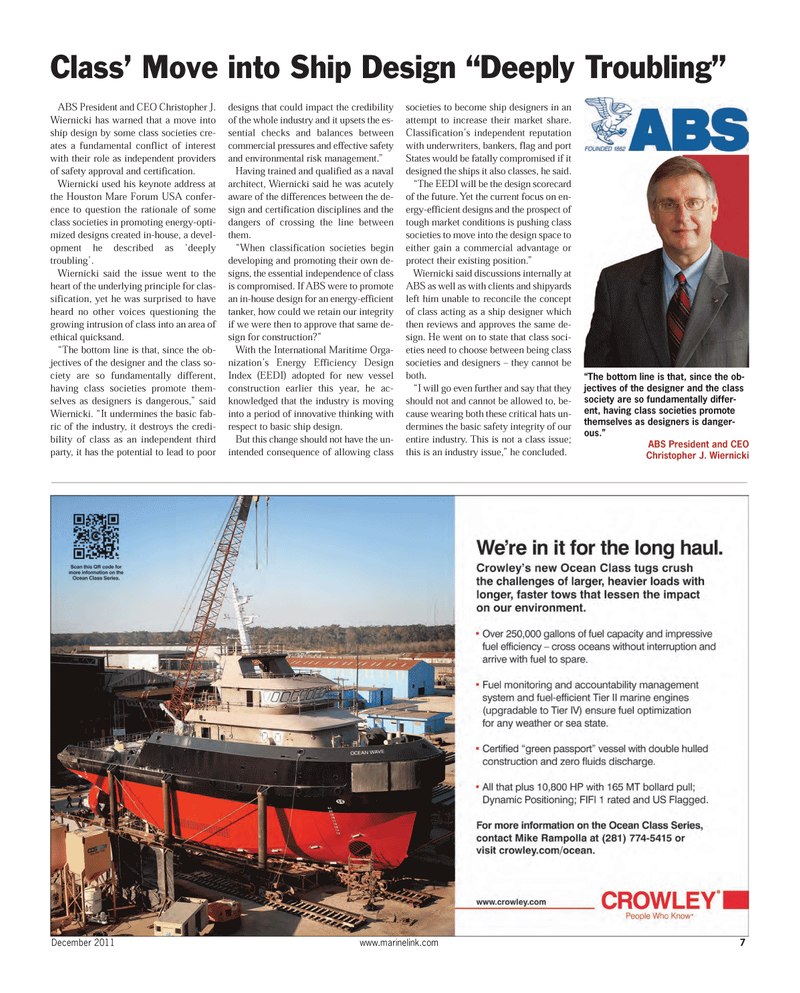
Page 7: of Maritime Reporter Magazine (December 2011)
Great Ships of 2011
Read this page in Pdf, Flash or Html5 edition of December 2011 Maritime Reporter Magazine
ABS President and CEO Christopher J.Wiernicki has warned that a move into ship design by some class societies cre-ates a fundamental conflict of interestwith their role as independent providers of safety approval and certification. Wiernicki used his keynote address at the Houston Mare Forum USA confer- ence to question the rationale of someclass societies in promoting energy-opti- mized designs created in-house, a devel- opment he described as ?deeplytroubling?. Wiernicki said the issue went to the heart of the underlying principle for clas-sification, yet he was surprised to have heard no other voices questioning the growing intrusion of class into an area of ethical quicksand. ?The bottom line is that, since the ob-jectives of the designer and the class so- ciety are so fundamentally different, having class societies promote them- selves as designers is dangerous,? said Wiernicki. ?It undermines the basic fab- ric of the industry, it destroys the credi- bility of class as an independent thirdparty, it has the potential to lead to poor designs that could impact the credibilityof the whole industry and it upsets the es-sential checks and balances betweencommercial pressures and effective safety and environmental risk management.? Having trained and qualified as a naval architect, Wiernicki said he was acutely aware of the differences between the de- sign and certification disciplines and the dangers of crossing the line betweenthem. ?When classification societies begin developing and promoting their own de- signs, the essential independence of classis compromised. If ABS were to promote an in-house design for an energy-efficient tanker, how could we retain our integrity if we were then to approve that same de- sign for construction?? With the International Maritime Orga- nization?s Energy Efficiency Design Index (EEDI) adopted for new vessel construction earlier this year, he ac- knowledged that the industry is moving into a period of innovative thinking with respect to basic ship design. But this change should not have the un- intended consequence of allowing class societies to become ship designers in anattempt to increase their market share. Classification?s independent reputation with underwriters, bankers, flag and port States would be fatally compromised if it designed the ships it also classes, he said. ?The EEDI will be the design scorecardof the future. Yet the current focus on en- ergy-efficient designs and the prospect of tough market conditions is pushing class societies to move into the design space to either gain a commercial advantage or protect their existing position.? Wiernicki said discussions internally at ABS as well as with clients and shipyards left him unable to reconcile the conceptof class acting as a ship designer whichthen reviews and approves the same de- sign. He went on to state that class soci-eties need to choose between being classsocieties and designers ? they cannot be both. ?I will go even further and say that they should not and cannot be allowed to, be- cause wearing both these critical hats un-dermines the basic safety integrity of our entire industry. This is not a class issue; this is an industry issue,? he concluded. December 2011www.marinelink.com 7Class? Move into Ship Design ?Deeply Troubling? ?The bottom line is that, since the ob-jectives of the designer and the classsociety are so fundamentally differ- ent, having class societies promote themselves as designers is danger- ous.?ABS President and CEO Christopher J. Wiernicki MR Dec.11 # 1 (1-9):MR Template 12/7/2011 4:05 PM Page 7

 6
6

 8
8
